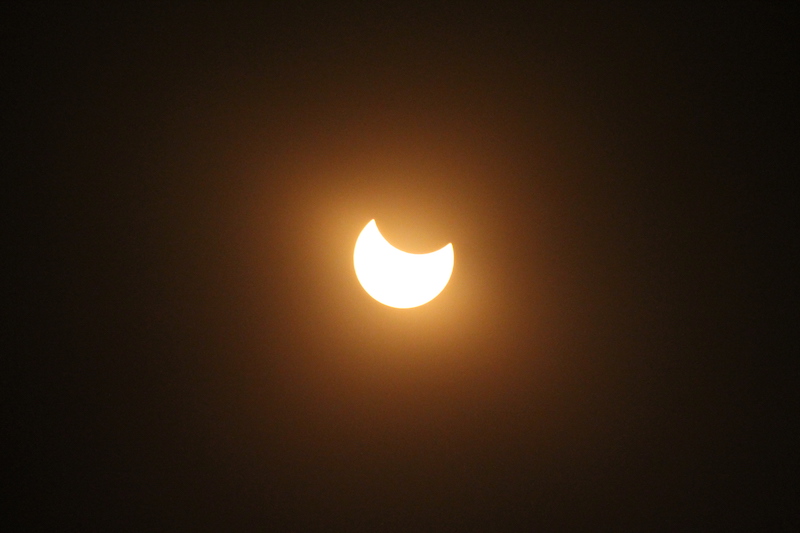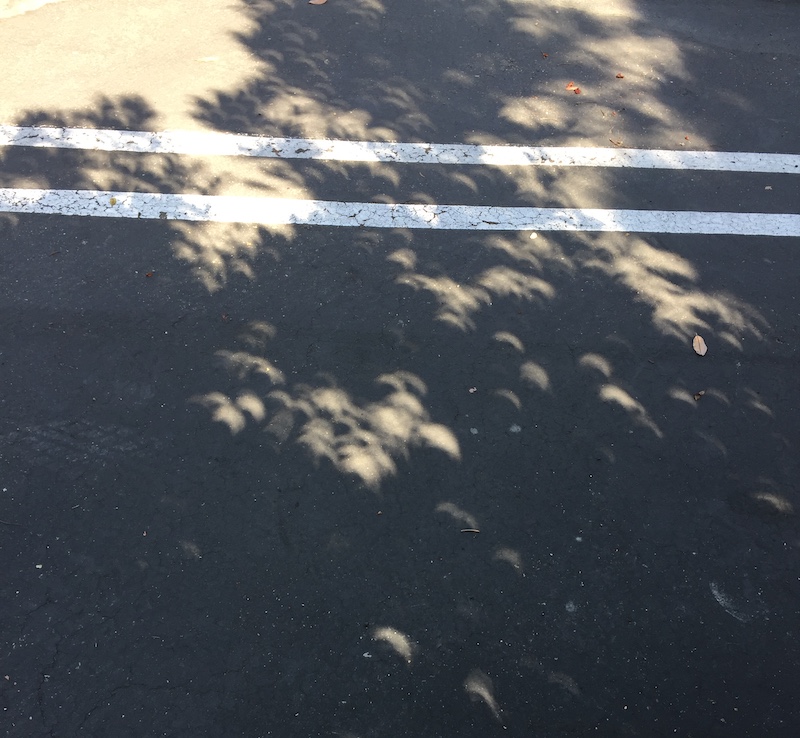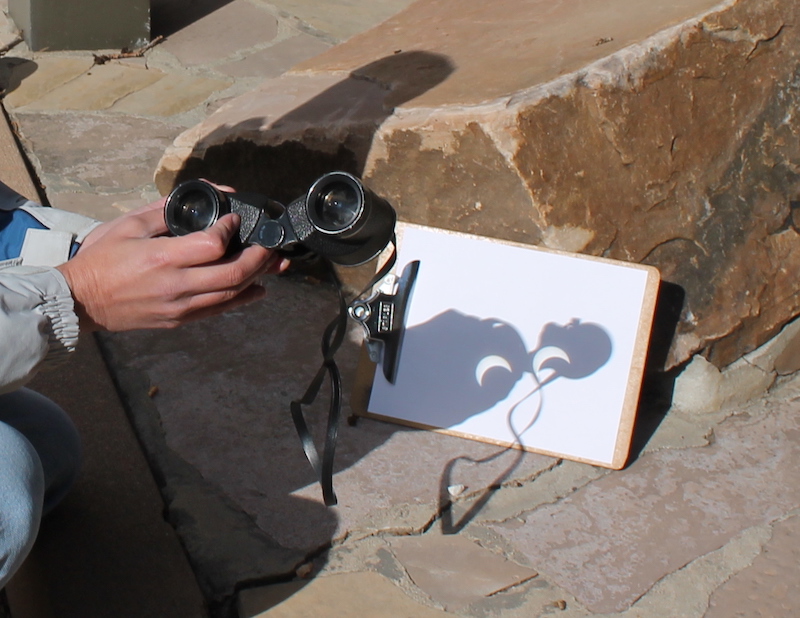Looking at the Sun
The sun isn't as dangerous as you might think, but there are some risks to watching an eclipse, and some ways you can safely get a much better look.
Isn't it Dangerous to Look Directly at the Sun?
Have you ever glanced at the sun, or any extremely intense light, and noticed that you see spots for a short time afterwards? These are normal afterimages, and they go away within a minute or so. But what happens if, instead of merely glancing, you stare at the sun for a long time? Most people wouldn't want to do this, because it hurts. The defensive mechanisms in your eyes are giving you a signal that maybe you should stop looking at the sun. But sometimes people stare at the sun anyway, perhaps for some ritual, or perhaps because something is blocking their pain signals and they don't realize that anything is wrong. These people see spots, too, but their spots take a long time to go away. These people have suffered from “solar retinopathy,” and they have a “scotoma,” or a hole in their vision, for several weeks or even several months. In extreme cases, their spots might never go away. (Ophthalmologists might disagree with this analogy, but I think of it like a cut or a scrape in your skin: Your retina can heal itself of small injuries, but in severe cases you might be left with a permanent scar. Your retina is just a patch of specialized light-sensitive skin, after all, as you may have discovered if you have ever dissected an eyeball.)
So on normal days, most people have little to fear from the sun. As long as you allow your eyes' natural adjustment and defensive mechanisms to function normally, you have no need to worry about a quick glance at the sun. And by the way, this is especially true when the sun is close to the horizon. Let the sun shine on your face at midday today. How do the light and warmth of the sunshine compare to those from the sunset tonight? The sun is strong when it is high, but when it is low, its rays have to pass sideways through the atmosphere to reach you, and its power is reduced to much more comfortable and safe levels. So go ahead and enjoy the beauty of sunrises and sunsets all you want, and you won't harm your eyes.
The problem with solar eclipses is that you have a reason to want to stare at the sun. When the sun is high in the sky, there is so much overpowering light surrounding it that you can't get a good look at the exact shape. All you see is a puddle of glare. So if you want to see exactly what's going on up there, you are tempted to stare, or to find some way to get a better look. This is where a little more care becomes necessary. A second problem with solar eclipses is that they can “mislead” or interfere with your eyes' normal defensive mechanisms. With most of the sun covered, the sun doesn't seem nearly so bright, and it doesn't seem as dangerous to stare, yet the portions of the sun that are still exposed are still emitting sunshine with the same intensity and can still harm your retinas. So with solar eclipses, extra precautions become necessary.
First of all, you obviously want to avoid staring. Do not stare at the sun when it is high in the sky, even if only a small portion of it is exposed. You also need to be extremely careful about looking at the sun through anything. You obviously don't want to look at the sun through binoculars or telescopes (at least not without special accessories). You may be tempted to look through binoculars or a telescope while wearing eclipse glasses on your face. Imagine holding a magnifying glass in the sunshine over your eclipse glasses, and you'll see why this is a bad idea. (You can see wonderful views of the sun by placing a “solar filter” on a telescope, but the filter has to go on the FRONT of the instrument, over the OBJECTIVE LENS, not over the eyepiece or over your eyes.) You should even be careful about looking at the sun through cheap sunglasses because, depending on the material, they can “trick” your eyes into thinking that it is relatively dark while still allowing all of the harmful UV rays into your eyes at full strength. You will also want to be wary about covering your eyes with “eclipse glasses” or otherwise allowing them to adapt to darkness, and then suddenly exposing them to direct sunshine without allowing them a moment or two to adapt to the light again.
A few websites may tell you to never, ever look directly at the sun, because it can cause you to go blind. The sun is not as dangerous as this type of hysterical prohibition makes it out to be, and you should not feel as if you need to hide your eyes every time you are outdoors. Your eyes are perfectly capable of protecting themselves from harm in normal circumstances, up to and including quick glances at a normal sun. A barely-eclipsed sun is no different from the sun on a normal day and is no more dangerous (other than making you want to stare at it). There are some risks to observing a deeper and darker solar eclipse, but as long as you act wisely and take some basic precautions, there is no reason you can't observe a solar eclipse safely. In a nutshell, don't stare even if it seems safe or comfortable to do so, and be very careful about looking at the sun through anything.
Getting a Better Look at the Sun
Whether or not it is harmful to look directly at the sun, it usually doesn't do much good. There is so much glare that it is very difficult to see the edges and the exact shape of things. If you want to get a better look at the exact shape of the sun, during an eclipse or on a normal day, you need some help.
One of the simplest and most effective ways is to buy a pair of “eclipse glasses.” These are specially made for looking at the sun, they are quite cheap, and they are similar to sunglasses but much, much darker. If you look through them at anything other than the sun, you will see nothing because they are so dark. If you look through them at the sun on a normal day, you will see a beautiful, perfect glowing disk. If you look through them at a solar eclipse, you will see a beautiful glowing disk with a piece missing.

Another way to see the shape of the sun is to make a pinhole projector. I'll let you search for detailed instructions elsewhere, but the basic idea is to place a tiny hole in the sunshine, and allow the sunlight coming through the hole to land on some kind of card or screen. The odd thing about pinholes is that, as long as the hole is small enough, the shape of the light spot that it makes has nothing to do with the shape of the hole and everything to do with the shape of the sun. Try making tiny holes with different shapes in a piece of black paper, and place them in the sunshine, and you'll see what I mean. We don't usually notice this effect in nature, because the sun is usually a circle, and circular light spots seem “normal.” But sometimes light spots are not circular. During a solar eclipse, try finding a place under a tree or next to a trellis where spots of dappled sunlight are landing in an otherwise shady place. If you can't find a suitable shady place, you can also try holding a colander in the sunshine.

Anyway, to return to the subject of an artificial pinhole projector, you will probably find the best results if you can place the “screen” several feet from the pinhole. The farther the screen is from the pinhole, the larger the image of the sun will be. Unfortunately, the farther the screen is from the pinhole, the dimmer the image will be, which leads me to my second point: Try to enclose the space between the pinhole and the screen to make it as dark as possible, while still allowing you to look inside and see the image on the screen. I once made a pretty good solar projector from a 10-gallon bucket and a long mailing tube, with a paper screen at the bottom of the bucket, and a pinhole in a piece of aluminum foil wrapped over the upper end of the mailing tube.
If you want to get an even better look at the sun, you can also — CAREFULLY! — use binoculars or a telescope. You can buy solar filters (which are basically “eclipse glasses” for your instrument) from various places online, and with solar filters on your binoculars or telescope, you can study a magnified sun as you would examine anything else in the sky. If you have a camera with a telephoto lens, you can place a solar filter over your camera lens and obtain pretty impressive photographs of the sun that way. (The auto-focus and auto-exposure features might not work properly, so you may have to adjust those manually.)
You can also simply use your binoculars or telescope as a projector: Instead of looking through them directly, place a card of some kind where your eye would have been but a bit farther away, adjust the focus, and you should be able to project an image of the sun onto your screen. (Doing this successfully with a pair of binoculars may take a little practice and a little manual dexterity, but it can be a cheap way of creating some pretty impressive images of the sun. As with the pinhole projector, however, you will probably want to position your screen in a shady place to improve the contrast. If you have a mirror, perhaps you can reflect the image of the sun out of the sunshine and into a dark corner.)
